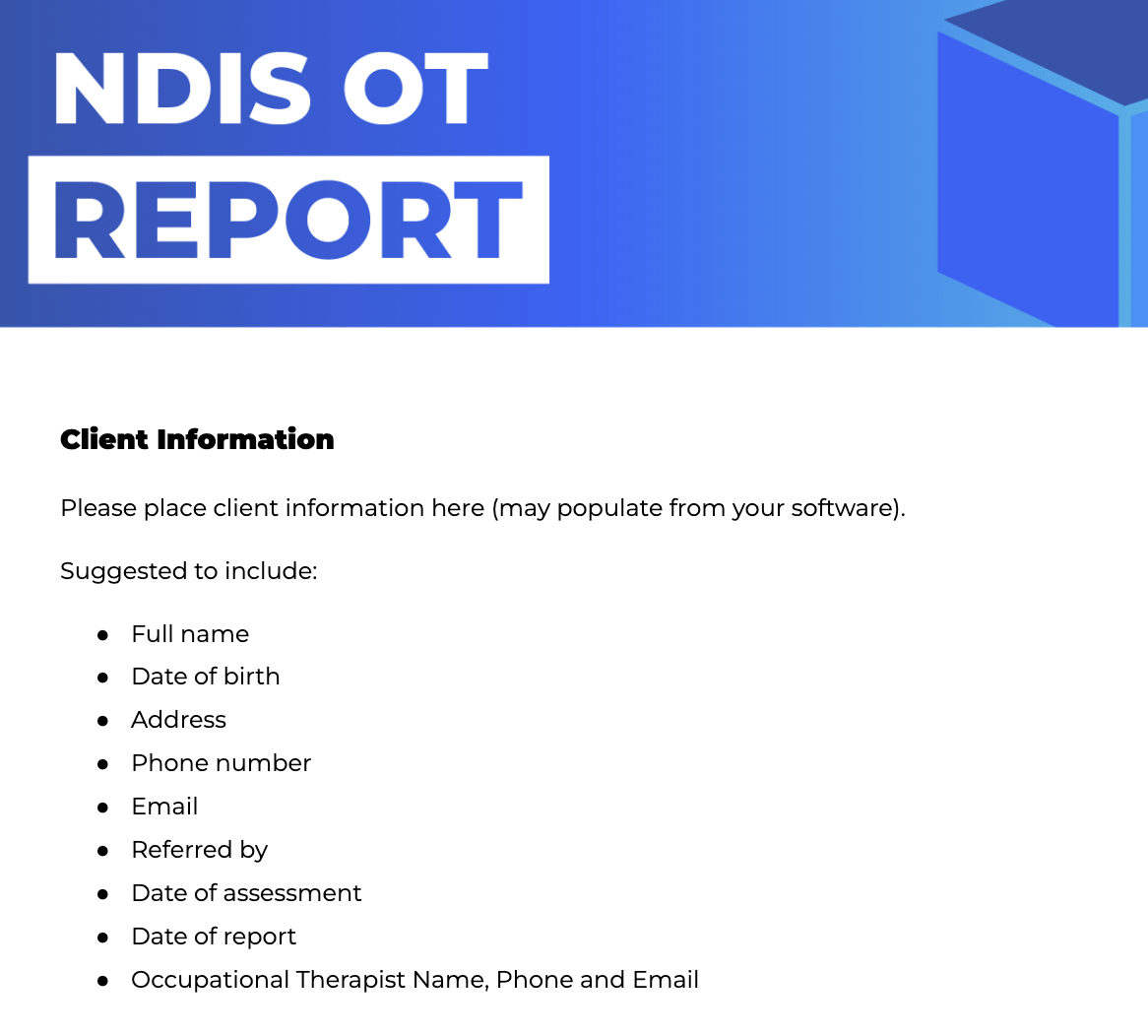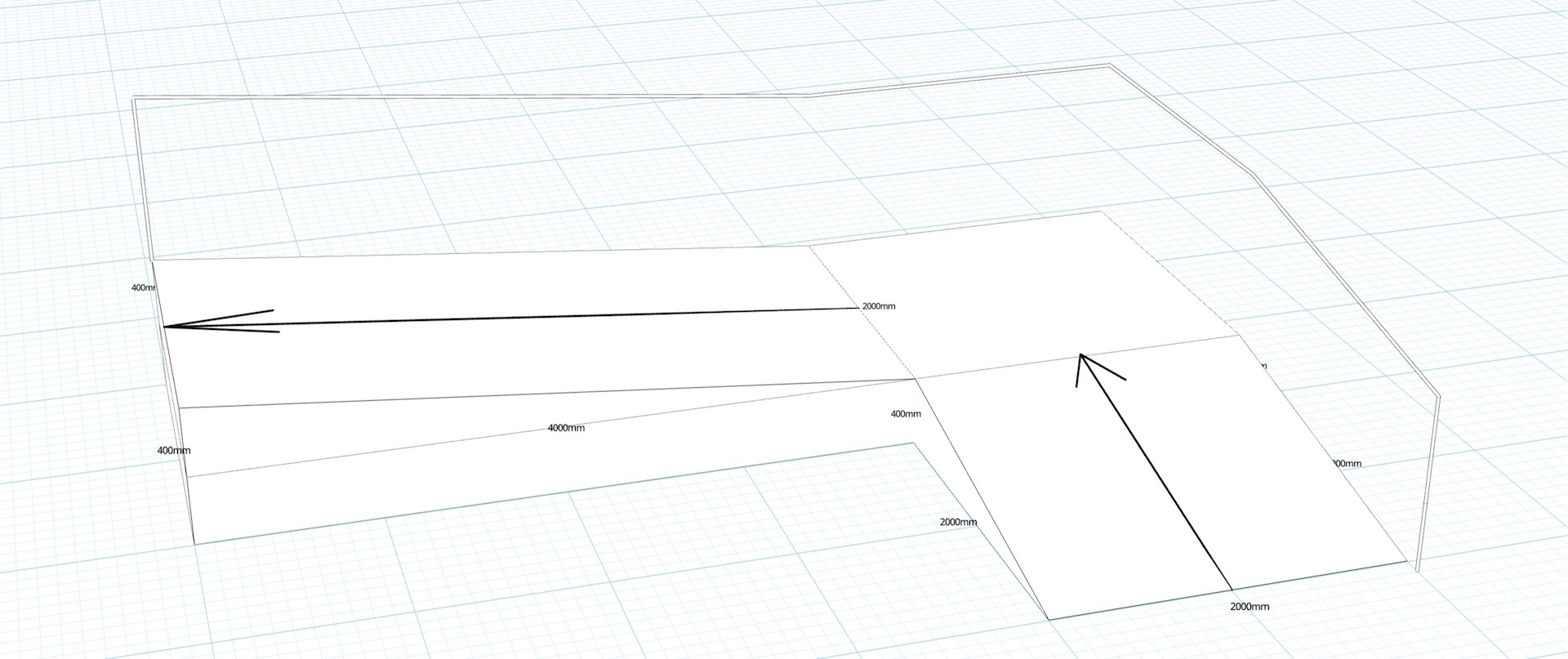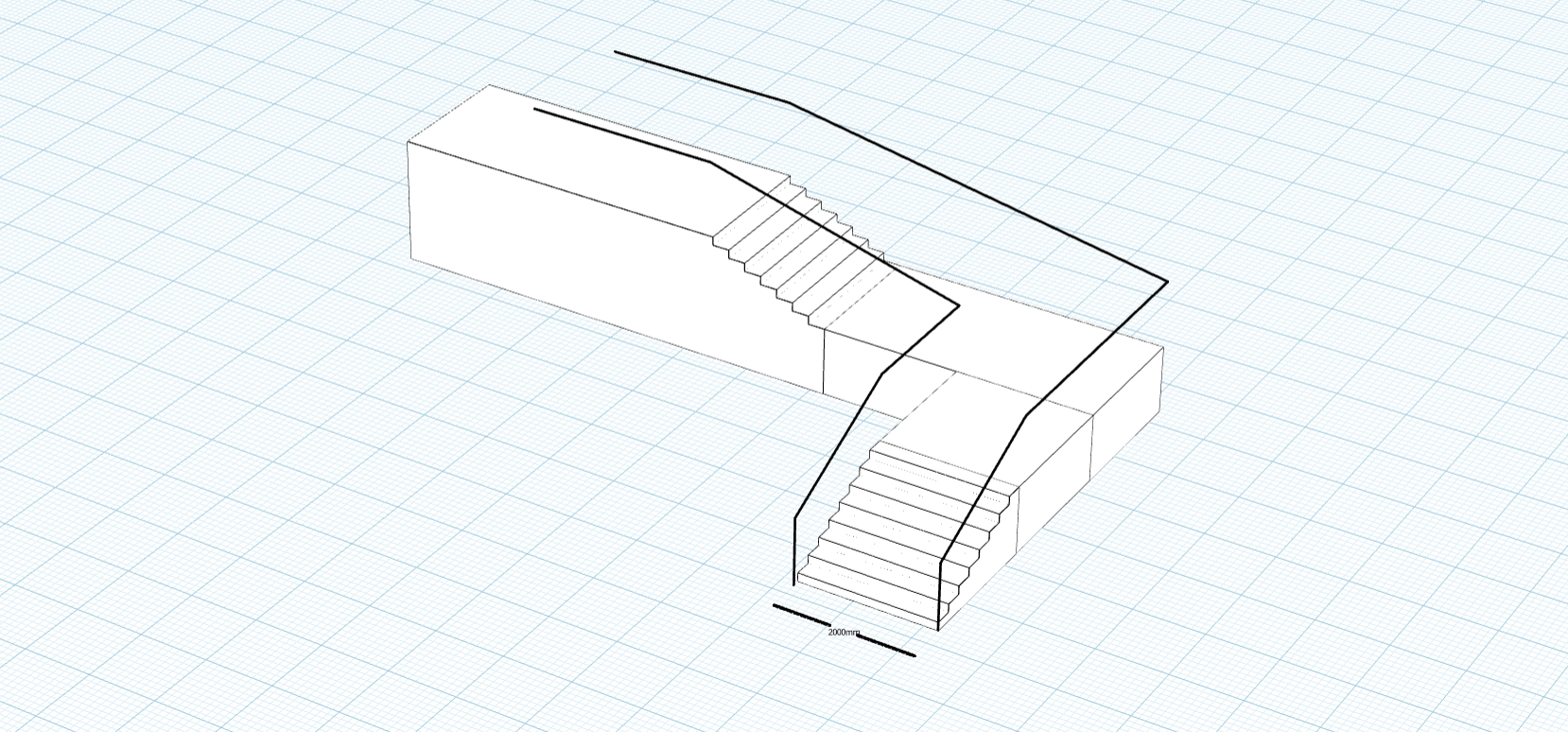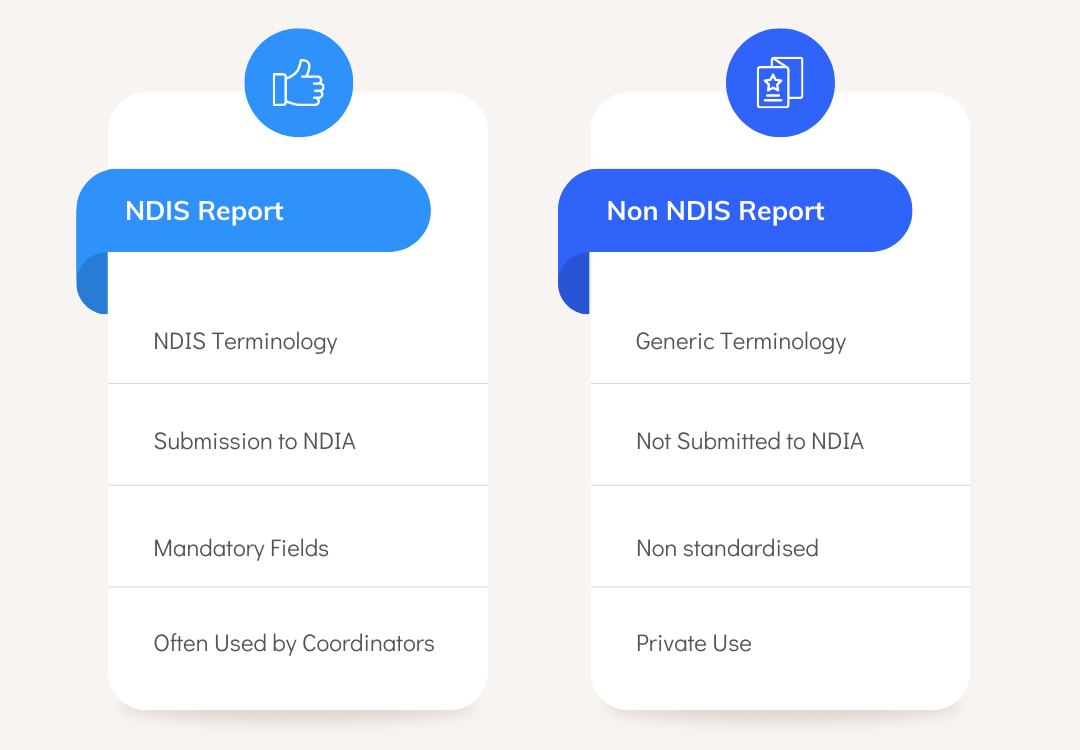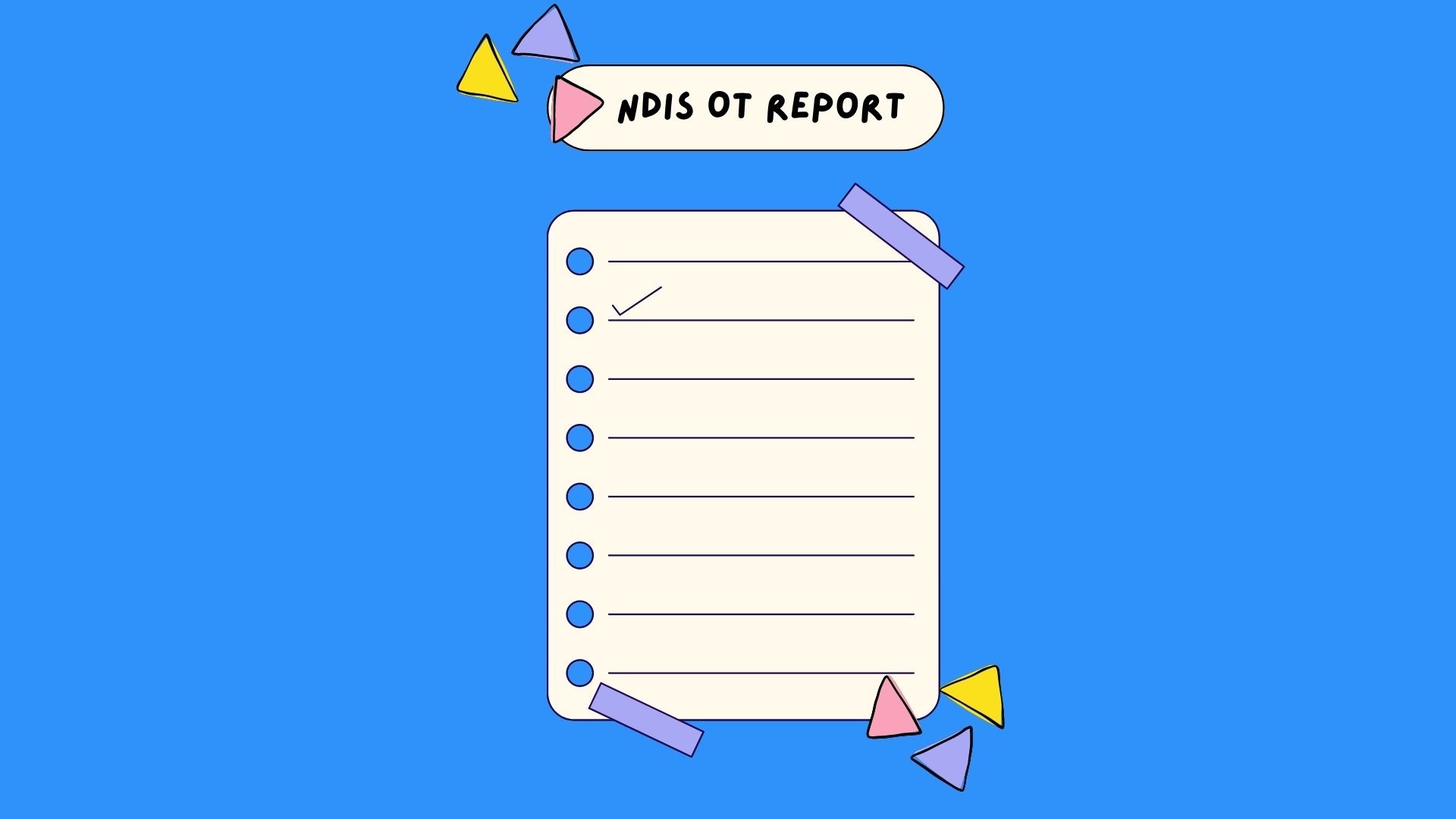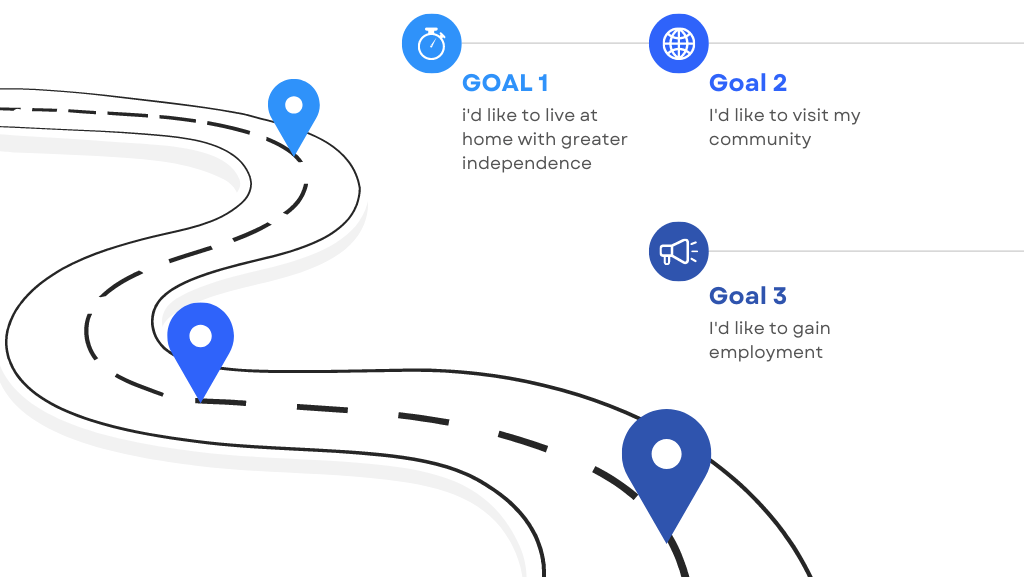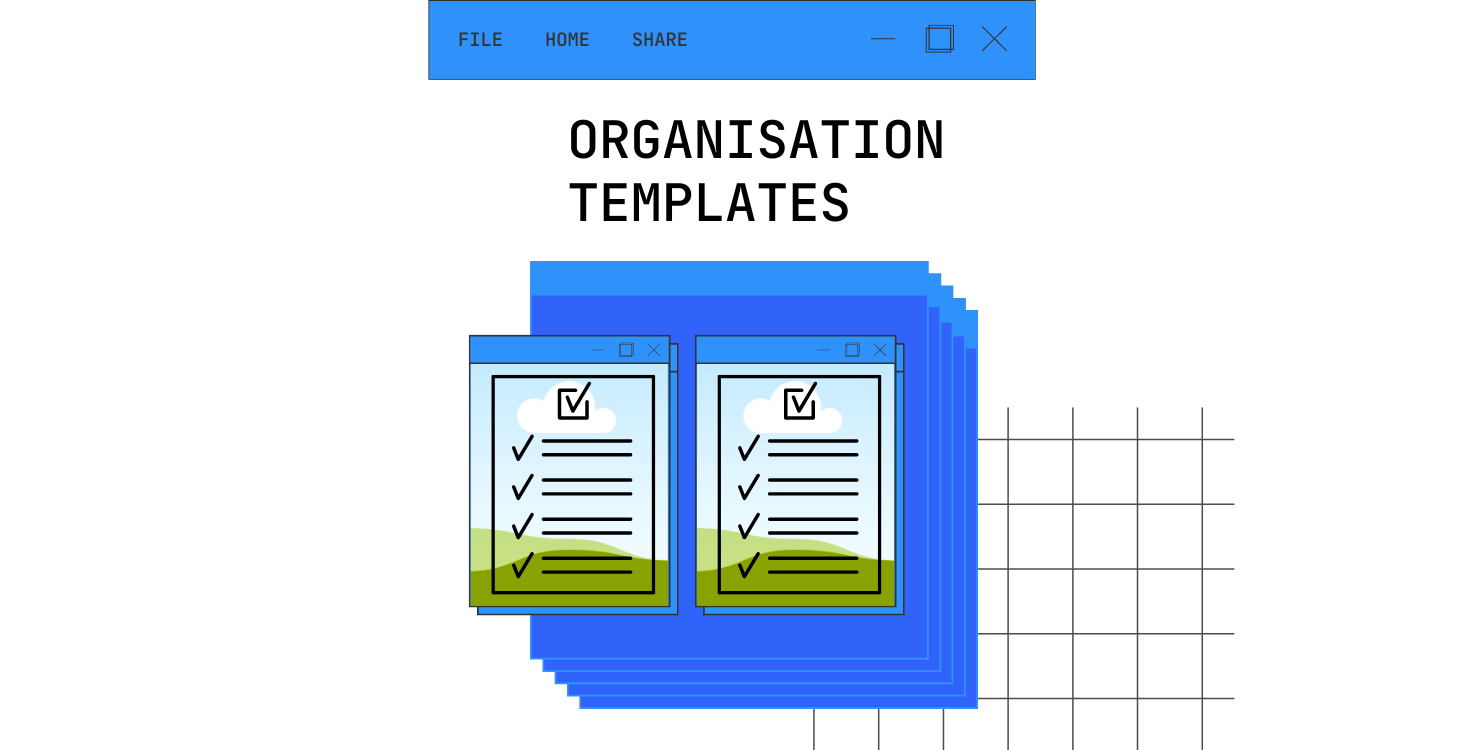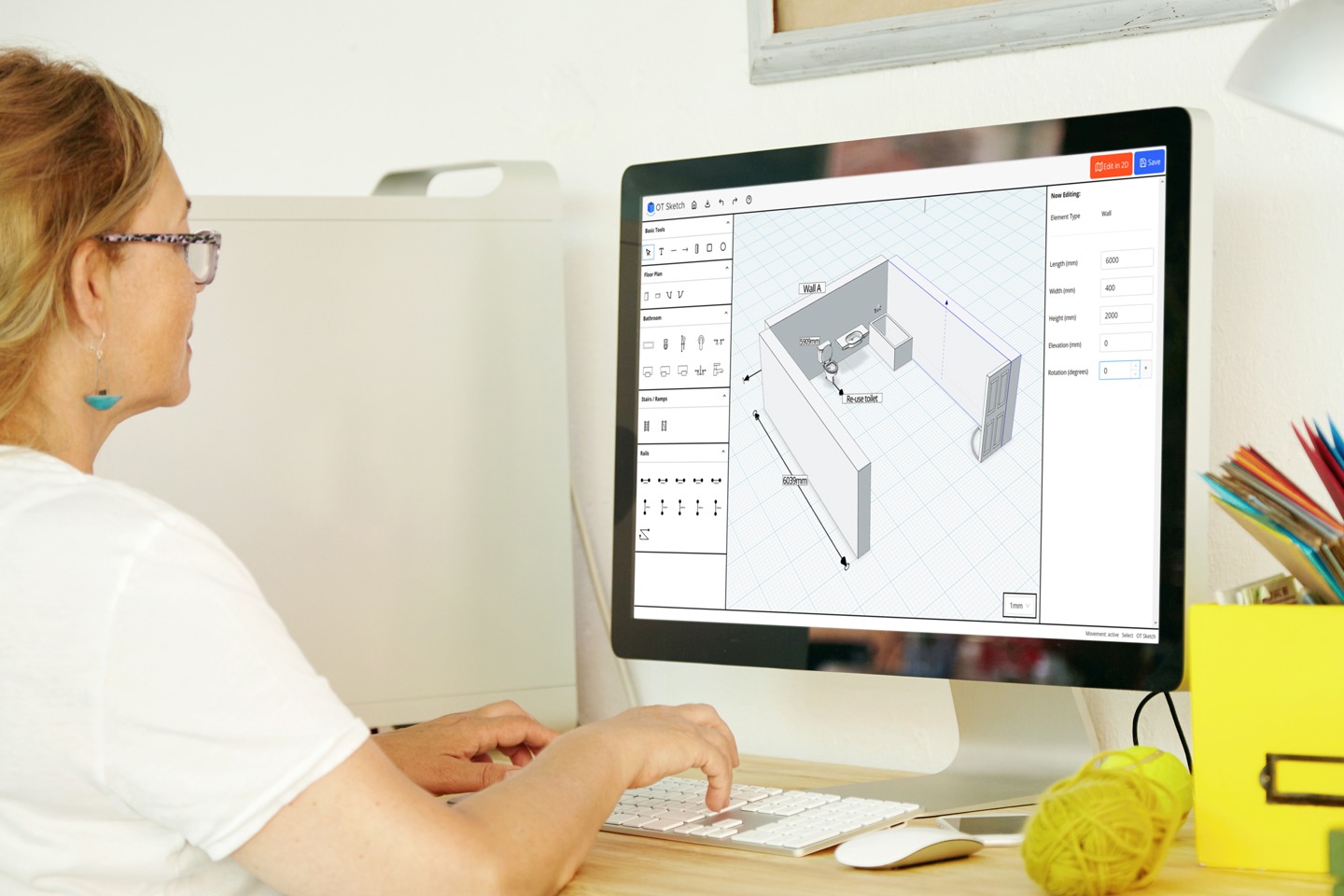Looking for a complete NDIS Occupational Therapy Report Template? Look no further!
We’ve put together the ultimate OT report template for OTs that will help you document in an efficient and professional manner.
We cover reporting fundamentals and NDIS report writing concepts in our article and you are free to download and edit our example OT report!
Download a Copy of our NDIS Occupational Therapy Functional Assessment Template
Click the button to download now.
Download a copy of our OT report template for free.
How to Use This NDIS Occupational Therapy Report Template
We’ve broken this document into sections that cover the main focus areas of OTs:
- Client information
- NDIS Specific Details
- Introduction
- Client Goals
- Primary Disability
- Medical Background
- Family and Social Support
- Services in Place
- Home Environment
- Activities of Daily Living
- Physical Function
- Cognition
- Equipment
- Recommendations Sections
- Summary Section
You’ll need to focus on all of the above for a holistic OT service. Make your way through our template to ensure you’re aware of best practices in each area.

By implementing these practices and resolving any current issues, you’ll likely deliver services in the best interest of your patient.
About This Resource
At OT Sketch (home modification software to draw home modifications) we are passionate about comprehensive and evidence-based assessments being completed by Occupational Therapists.
We acknowledge that Occupational Therapy assessments are comprehensive with a wide range of care needs being covered.
Consequently, an OT report template needs comprehensive to support OTs to efficiently and professionally capture relevant information during their assessments.
We created this resource to support Occupational Therapists to increase the specificity and ease of use of the templates in which they use, in particular when supporting people living with disabilities with funding under the NDIS in Australia.
PS – Want a free trial of OT Sketch? Let us know via our contact page.
Contact Us
12 NDIS Occupational Therapy Report Template Notes
The NDIS can be complex for an Occupational Therapist to navigate and this includes the OT reporting needs of the NDIS.
An Occupational Therapist, and business, need to ensure they are meeting the documentation requirements of bodies such as AHPRA, NDIS and their Insurer.
The following points cover important information that you need to know or consider when creating an OT report template that will support the completion of efficient and professional OT reports.
1 – Understanding the NDIS
At OT Sketch, we like to keep things simple. When creating an NDIS OT report template, it is important to first understand what the NDIS is.
The NDIS stands for the National Disability Insurance Scheme, which is an insurance scheme in Australia for people that are living with disabilities.

That may be a disability that they are born with or a disability that has been acquired during their life.
The NDIS is a federal scheme with partnerships with states and territories throughout Australia, and it is considered a world-leading disability insurance scheme.
The NDIS has specific access requirements defined in the NDIS Act.
The National Disability Insurance Agency (NDIA) is responsible for administering the NDIS.
Occupational Therapists supporting NDIS participants will regularly complete OT reports that will be used by NDIS participants as supporting documentation for the NDIA to consider whether supports and interventions (such as home modifications possibly designed with OT Sketch) are considered reasonable and necessary under the NDIS Act (discussed later in this article).
2 – What is a NDIS Occupational Therapy Report Template?
An NDIS Occupational Therapy Report Template refers to a document template that an Occupational Therapist will use when completing and documenting an assessment for an NDIS participant.
There can be many types of different templates depending on the purpose for which that particular template is required.
Some NDIS templates will be company-controlled and the intellectual property of the company.
Whereas, other report templates may be provided by the NDIA, which is the National Disability Insurance Agency, and one example of those is the Assistive-Technology General Template.
An organisation will typically have several types of NDIS OT report templates and our example template would be considered appropriate for NDIS OT functional capacity report template.
Types of NDIS Occupational Therapy Reports
There are many different types of NDIS Occupational Therapy reports, and some of those include:
- Functional Capacity or Functional Assessment Reports
- Home modification reports
- Supported Independent Living (SIL) reports
- Apecialist Disability Accommodation (SDA) reports and;
- Assistive Technology (AT) reports
Difference Between a NDIS and a Non-NDIS Report
At a broad level, the care needs (which can be identified and assessed in an Occupational Therapy initial assessment and documented in a report) can be similar between different funding streams.
This may be an older adult through age care programs, or a person living with a disability with funding through the NDIS, or other funding streams such as Lifetime Care and Support.
Some of the predominant differences, however, with an NDIS Occupational Therapy Report will be the specific NDIS terminology that will be used in the report.
Several examples of this specific terminology per the NDIS legislation and act would be:
- Reasonable and necessary
- Assistive technology commonly referred to as AT
- Different levels of complexity of AT such as low, mid and high-cost, or low and high-risk
- Supported Independent Living (SIL)
- Specialist Disability Accommodation (SDA)
There are many more acronyms that are NDIS-specific, which will often make the largest difference in terms of identifying whether an Occupational Therapy report is NDIS-specific or general in nature.
3 – When a Report Template is Used
Common Scenarios
An NDIS participant will often require an Occupational Therapy report for several reasons.
The first time may be to support their access to the NDIS – to become a participant of the NDIS people often require supportive documentation to support the access request for the NDIA to review.
Some of the more common reasons, however, that an Occupational Therapy report would be required by an NDIS participant is to support a plan review to determine what types of reasonable and necessary supports may be indicated in the NDIS participant’s next plan.
An Occupational Therapy report can often be required to identify Assistive Technology or home modifications, or to identify a different change of housing or accommodation need for a participant.
Who Can Request an NDIS Occupational Therapy Report
The parties who commonly request NDIS assessments are:
- The NDIS participant themselves
- Their NDIS Support Coordinator
- A Local Area Coordinator (LAC)
- NDIA Planner
When to Deliver Occupational Therapy Multiple Reports
An NDIS participant can often have multiple OT reports if there are multiple complex care needs requiring support.
 An example could be an initial functional assessment and report that takes place – during which it is identified that complex home modifications and high cost Assistive Technology is required.
An example could be an initial functional assessment and report that takes place – during which it is identified that complex home modifications and high cost Assistive Technology is required.
Therefore, both a home modification report (associated drawings and scopes of works) + Assistive Technology report (associated trials and quotes) would be required.
4 – How to Write Professional Reports
Language
In an NDIS Occupational Therapy Report, the language used by the Occupational Therapist will vary depending on the different sections of the report. This is common across all types of Occupational Therapy reports.
An example of this would be in the subjective section of the Occupational Therapy report, some of the language will be from the perspective of the participant themselves (i.e. self-reported outcome measures & self-reported statements about their goals and identified care needs).
Throughout the rest of the report, which we could broadly classify as the objective part of the assessment, the language will be much more objective in nature.
Readability of the Report
Having an easy-to-read-and-navigate Occupational Therapy report is critical for consumers and stakeholders alike.
It’s also important for other Allied Health professionals to be able to easily read an Occupational Therapy report in regards to multidisciplinary practice.
The aspects of an Occupational Therapy report to pay attention to are:
- Clear headings
- Clear Summary and Recommendations section
- Clear document structure and separation of sections (Summary, NDIS Participant Information, NDIS Participant Plan Details, About, Subjective Assessment, Objective Assessment, subheadings to different areas of Activities of Daily Living)
It should also be considered whether a Summary and Recommendation section can be placed towards the front of a report for easy access, as NDIS Occupational Therapy Reports can be quite long, so having a summary on the front or second page can make navigation easy for consumers and stakeholders.
5 – Critical Information Within the Report
The mandatory information within an NDIS Occupational Therapy report can vary.
The reason for the report and the type of NDIS Occupational Therapy report used will alter the final contents.
An example of this is a Functional Assessment report, which can be broad in nature, covering all different types of care needs and activities of daily living, equipment prescriptions and environmental needs for a participant.
An NDIS Occupational Therapy report, however, may often be more specific around assessing and prescribing Assistive Technology.
The nature of that Occupational Therapy report would be much more targeted towards noting specifications of the assistive technology, why that assistive technology represents value for money, documenting trials that have taken place around determining if that assistive technology was suitable for the participant.
Evidence-Based Reporting
Depending on the reason for the NDIS Occupational Therapy Report being requested, the evidence required or provided in the report will be dependent on that request.
Broadly speaking, an NDIA planner or other delegate of the NDIA CEO are the only people that are able to determine whether a recommended support is considered ‘reasonable and necessary’ under the NDIS Act.
Therefore, it is the responsibility of the Occupational Therapist to conduct an evidence-based assessment and complete an objective report to identify care needs and recommended interventions that are evidence-based and in line with an NDIS participant’s meaningful goals.
It is not the responsibility of the Occupational Therapist to determine if a support or intervention will be considered reasonable and necessary by the NDIA.
Demonstrating Progress Towards Goals
Arguably, meaningful goals of an NDIS participant (or any consumer that an Occupational Therapist is supporting) are one of the the most important components of the assessment or report to identify and document.
One of the primary reasons that Occupational Therapists are in practice; is to support those we care for to move towards achieving their meaningful goals.
Goals can be quite broad in nature; in terms of working towards independence in different areas of activities of daily living, or leisure and employment.
At other times, goals may be more specific to improving different outcome measures relating to the risk of acquiring a associated medical conditions (i.e. falls or pressure area risk outcome measures improving as part of a goal).
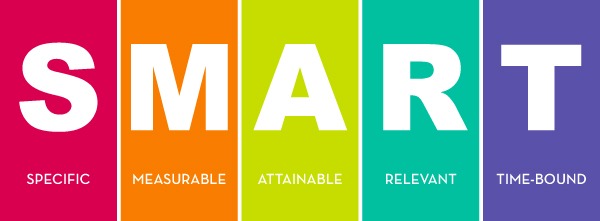
One of the most important pieces to identify in goal-setting and progress-tracking is around SMART goal-setting.
Representing Value for Money
Value for money is an example of an NDIS-specific piece of terminology, however, is occasionally used under other funding streams too.
For an Occupational Therapist, value for money means that when recommending support or interventions you should consider and document whether it represents value for money for the NDIS and its expenditure as a scheme in the short, medium and long term.
A simple example of this concept is an Occupational Therapist who may review the need for a specific type of wheelchair for an NDIS participant.
The OT may identify two different chairs that meet the participant’s care needs and meaningful goals.
For example, there may be a price difference where one wheelchair is significantly dearer in the short term, however, it provides significant value for money and cost savings in the long term.
This could be due to different functional abilities of the chair, which may decrease the need for the NDIS participant to receive extensive personal care support and community transport funding.
The chair may also have much longer lifespan in terms of replacement and repair costs.
Value for money is an ingrained piece of terminology that NDIA planners, LACs and other stakeholders in the NDIS will reference.
Reasonable and Necessary
Reasonable and necessary is another example of very NDIS-specific terminology.
Simply put, reasonable and necessary is inbuilt into the NDIS Act (the legislation by which the NDIA must adhere to) to help govern operations of the NDIS.
As previously stated, the NDIA CEO or delegate of is the only party that is able to determine whether a support or service is deemed reasonable and necessary under the NDIS Act.
There are certain criteria within the NDIS Act that must be adhered to by the NDIA CEO or delegate in determining whether a support is reasonable and necessary.
Broadly speaking, reasonable and necessary supports or services need to be considered:
- Must be related to a participant’s disability
- Must not include day-to-day living costs not related to your disability support needs, such as groceries
- Should represent value for money
- Must be likely to be effective and work for the participant, and
- Should take into account support given to you by other government services, your family, carers, networks and the community.
Providing Clear Recommendations
An important part of an Occupational Therapy report is clear and actionable recommendations.
A recommendation section should be on the summary page (first 1-2 pages of the report) or at the very end.
In the recommendation section, each recommendation should have its own area, which can be numbered or bulleted.
One example of a clear recommendation could be:
- Outcome: the care need is pressure area risk
- Recommendation: The recommendation will be purchase of recommended pressure area cushion as identified in successful trial to be purchased by NDIS participant. Occupational Therapist has provided NDIS participant with quote.
It is recommended that a care need be associated with the recommendation, and the action to be clear with who is responsible for that action.
6 – NDIS Specific Information
NDIS Occupational Therapy Reports to Support NDIS Reviews or Appeals
An NDIS Occupational Therapy Report is often used as supporting evidence by an NDIS participant or NDIS nominee.
A NDIS nominee is somebody with the power to act on behalf of an NDIS participant, including during an NDIS review or appeals process.
An NDIS planner will be able to refer to the NDIS Occupational Therapy Report and other supporting evidence provided by the participant or nominee to make a determination whether the recommended supports or interventions are deemed reasonable and necessary against the NDIS Act.
Submission to the NDIA
An NDIS Occupational Therapy report should be submitted to the NDIA in the way in which the NDIS participant, or their plan nominee consents.
This may be directed to the NDIA via their general inquiries email. However, there are several other ways reports can be submitted to the NDIA.
- This could be by providing the report to the participant or their plan nominee, and they will provide that to the agency, possibly through the NDIS portal
- Other avenues, with consent, maybe through to a local area coordinator, or their support coordinator
- Other times, it may be appropriate and deemed necessary to provide that directly to an NDIA planner that is already engaged in a process of supporting the participant through something, such as a plan review
Feedback on Reports from the NDIA
It is common for a NDIS participant, NDIA planner, local area coordinator, or support coordinator to provide advice and recommendations for an Occupational Therapist to consider regarding their Occupational Therapy report.
This can be providing the Occupational Therapist with additional information that was not provided or accessible for the Occupational Therapist at the time of report.
This could also include new information, or a change in care needs, or status for an NDIS participant, such as where they live, or the status of their disability and required care needs.
At times, there may also be feedback regarding additional information required in an Occupational Therapy report to support an NDIA planner to make a decision against the reasonable and necessary criteria of the NDIS Act.
7 – Reading & Sharing Reports
It is important to note that an NDIS participant, or their plan nominee have the power and authority to provide consent to who that report is provided to and read by.
An NDIS Occupational Therapy report can be read by many people.
First and foremost, it can be read by the NDIS participant, their plan nominee, family and/or friends (with consent).
It is important part of an Occupational Therapist’s practice, or their organisation’s procedures to have clear consent processes in place. Typically this takes form in a service agreement document.
The service agreement will list who has been granted consent by the NDIS participant as to who can access the information inside the report.
With consent, the report may also be provided to other stakeholders (such as GPs, LACs, support staff, support coordinators and the NDIA staff).
It is important to keep in mind, when completing a report, that it may be read by many parties. Maintaining objectivity and professional language throughout the report is very important.
8 – Managing Templates Within an Organisation
There are different ways in which organisations manage their documentation/report templates.
Typically, an organisation will be using either practice management software and/or workplace software such as Microsoft 365 or Google Workspace.
These types of systems have report template functions and document library features.
An important part of documentation management is making sure that organisations have a documentation register to track what report templates they actually have, where they are located, when they are updated and with previous versions archived.
9 – Support from Consulting Organisations
There are many consulting organisations in Australia that support Allied Health organisation or Allied Health professionals.
Common situations for consultation include:
- Supporting OTs with their NDIS registration against the NDIS practice standards
- Supporting OTs with verification or certification pathways (required to offer services to NDIA-managed NDIS participants)
- General business operations, development of SOPs, recruitment, etc
In terms of support that is specific to Occupational Therapy report templates, there are fewer options in the market.
Well-established Allied Health providers, such as Community Therapy offer consultancy services for Allied health organisations.
10 – Professional Development for OT Graduates
Graduates Learning to Operate Under The NDIS
An Occupational Therapist new graduate may have had some exposure to supporting NDIS participants as part of their undergraduate placements.
Regardless of this, Occupational Therapists should be supported by their organisation in their onboarding and general supervision through their first year as a clinician to increase their knowledge of the NDIS.
In combination with this, Occupational Therapists against their standards with AHPRA are responsible for their own continuing professional development each year.
And as part of that, if supporting NDIS participants should be actively seeking to upskill their own knowledge against the NDIS requirements.
Occupational Therapists in Australia should review CPD opportunities offered by Occupational Therapy Australia.
Learning NDIS Occupational Therapy Report Template Writing
Most small, medium and large Allied Health organisations will have their own NDIS Occupational Therapy reports.
It is standard practice (as part of onboarding, supervision and induction periods) for OTs to be provided with buddying/training on how to complete the different types of reports that the organisation completes.
Occupational Therapists can reach out to colleagues, or Occupational Therapy Australia for required support. This is more commonly the case for sole traders or small organisations.
11 – Following Up After Delivering an Occupational Therapy Report
Under the NDIS Act, the NDIA (who is responsible for operating the scheme) has timelines imposed on it in terms of providing responses back to NDIS participants around the status of their requests.
These situations may be a change in circumstances, a request for a review of their plan, or a request for a determination of if interventions, recommendations are deemed reasonable and necessary.
Those timelines can vary depending on the nature of the request however are commonly 28 days for many types of requests.
Final Thoughts
As part of an Occupational Therapy report that is focused on home modifications, whether minor or major, the most important part of that report is having a clear drawing and associated Scope of Works and quotes.
This is for the NDIA to make a determination of whether those modifications are deemed reasonable or necessary.
It can be quite complex (as many may know!!) to accurately and easily draw home modifications both in 2D and 3D landscapes.
OT Sketch solves that problem by making it easy for Occupational Therapists to accurately and easily draw minor and major home modifications.
![]()


